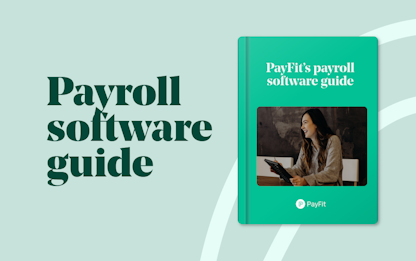- Blog
- |People management
- >Employee wellbeing
- >Global mobility
What is global mobility and what do employers need to take into consideration?


In a new post-pandemic world, the workplace has dramatically changed. Remote working has become the norm, and companies have started to allow their employees to work from home or come into the office as they’d like. Some companies have also allowed their employees to work from anywhere in the world!
Imagine taking your meetings at a cosy family cottage or writing your report at a beach house that you finally have time to visit more often.
Sounds great, doesn’t it?
Employees are getting used to their new routine and show little sign of returning to the daily city commute. However, before they go and book their one-way tickets to the sun, there are some things that employers need to consider. Things like; what does this mean for employee tax? Will the employees have to pay tax in two countries? Who decides the rules?
So we’re going to write a couple of articles on the topic of global mobility to make it easier for employers to understand and take action.
What is Global Mobility?
After becoming a more common option for employers to allow employees to work temporarily or permanently in different countries, especially after the pandemic, it led to an increase in companies offering more flexible working solutions.
So what exactly is Global Mobility? Global mobility refers to the process where companies have employees based internationally and outside of where their payroll is processed. That could be a UK employer with employees based outside of the UK or a non-UK employer with employees based within the UK. Such arrangements can potentially impact tax and national insurance (NIC) liability. It means that both the employer and employee need to consider how global mobility will affect them and if that is a suitable option. But what do employers need to think about when it comes to offering global mobility in their business?
Why Global Mobility?
Here are some benefits of offering global mobility to employees:
Better time management
Work-life balance
Mental wellbeing
Healthier lifestyle
Employee retention
Apart from avoiding the daily commute, there are more benefits of offering remote working options. Giving your employees the flexibility to work remotely can actually improve their mental health and wellbeing as research shows that remote and flexible working can lower stress levels.
People with families or pets have been able to spend more time at home and juggle family tasks by not having to travel to the office, so they can manage their time better.
Working from home also enables people to prepare their lunch at home, so oftentimes, they are eating healthier and more likely to squeeze in some time for exercise during the day.
Ultimately, happier employees and flexible arrangements can lead to higher engagement and retention.
What do employers need to think about when offering global mobility?
The first step is to establish your employees' tax residence.
Do employees have the flexibility to work outside of the UK?
Do employees have the flexibility to come to the UK to work?
If the answer is yes to either of these questions, employers must make sure tax and National Insurance is assessed and processed correctly.
Statutory Residence Tests and Ties
Statutory Residence Test (SRT) is the process that determines the UK tax residence status of individuals with connections to the UK.
If you meet 1 of the Automatic Overseas Tests, you are not a UK tax resident.
If you meet 1 of the Automatic UK Tests, you are a UK tax resident
If you meet neither of the above tests, you would need to look into the “Sufficient Ties Test.”
Automatic Overseas Tests
| Automatic Overseas Tests | |
|---|---|
| 1 | You’ll be a non-UK resident for the tax year if you were resident in the UK for one or more of the 3 tax years before the current tax year, and you spend fewer than 16 days in the UK in the tax year. |
| 2 | You’ll be a non-UK resident for the tax year if you were resident in the UK for none of the three tax years before the current tax year and spend fewer than 46 days in the UK in the tax year. |
| 3 | You’ll be a non-UK resident for the tax year if you work full-time overseas over the tax year and you spend fewer than 91 days in the UK in the tax year the number of days on which you work for more than 3 hours in the UK is less than 31 there is no significant break from your overseas work |
| A “significant break” is when at least 31 days go by, and not one of those days is a day where you: | |
| · Work for more than 3 hours overseas | |
| · Would have worked for more than 3 hours overseas, but you did not do so because you were on annual leave, sick leave or parenting leave |
Automatic UK Tests
| Automatic UK Tests | |
|---|---|
| 1 | You’ll be a UK resident for the tax year if you spend 183 days or more in the UK in the tax year. |
| 2 | You’ll be a UK resident for the tax year if you have, or have had, a home in the UK for all or part of the year and the following all apply: |
| · There is or was at least one period of 91 consecutive days when you had a home in the UK at least 30 of these 91 days fall in the tax year when you have a home in the UK, and you’ve been present in that home for at least 30 days at any time during the year | |
| · At that time, you had no overseas home, or if you had an overseas home, you were present in it for fewer than 30 days in the tax year | |
| 3 | You’ll be a UK resident for the tax year if all the following apply: |
| · You work full-time in the UK for any period of 365 days, which falls in the tax year | |
| · More than 75% of the total number of days in the 365 day period when you do more than 3 hours work are days when you do more than 3 hours work in the UK | |
| · At least one day, which has to be both in the 365 day period and the tax year is a day on which you do more than 3 hours of work in the UK |
Sufficient Ties Tests
Sufficient ties tests are used when the employee’s tax liability is not determined through the automatic overseas and automatic UK tests.
A sufficient tie is something that connects you to the UK outside of employment and working location and is broken down as:
A family tie
An accommodation tie
A work tie
A 90-day tie
They are slightly more complex as the number of ties needed depends on the number of tax years already spent in the UK as a resident and how many days spent in the UK.
If you were a UK resident in the UK for one or more of the previous three tax years, your ties are as follows:
If you were not a UK resident at all in the three previous tax years, your ties are as follows:
| Days spent in the UK in the tax year under consideration | UK ties needed |
|---|---|
| 16 - 45 | At least 4 |
| 46 - 90 | At least 3 |
| 91 - 120 | At least 2 |
| Over 120 | At least 1 |
| Days spent in the UK in the tax year under consideration | UK ties needed |
|---|---|
| 46 - 90 | All 4 |
| 91 - 120 | At least 3 |
| Over 120 | At least 2 |
There is no one rule for all employees working abroad - it needs to be dealt with proactively and on a case-by-case basis.
We have now gone over the first step for employers to establish their employees' tax residence when offering global mobility. In our next article, we'll talk about how global mobility can affect tax, and what the options are for you and your employees.
Keen to find out more about PayFit? Book a demo with one of our product specialists today.

PayFit disclaimer
The information contained in this document is purely informative. It is not a substitute for legal advice from a legal professional.
PayFit does not guarantee the accuracy or completeness of this information and therefore cannot be held liable for any damages arising from your reading or use of this information. Remember to check the date of the last update.

The 2024 UK National Living Wage - An Employer’s Guide

The Cost Of Recruitment In The UK - What You Might Not Know

UK National Insurance Changes for January 2024

End Of Tax Year 2023/2024 - Eight Key Changes For 24/25

Strategies to Reduce Employee Turnover

